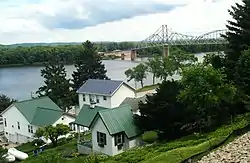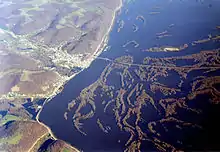Lansing, Iowa | |
|---|---|
 | |
| Motto: Where Main Street Meets The Mississippi[1] | |
 Location of Lansing, Iowa | |
| Coordinates: 43°21′41″N 91°13′24″W / 43.36139°N 91.22333°W | |
| Country | |
| State | |
| County | Allamakee |
| Township | Lansing |
| Area | |
| • Total | 1.17 sq mi (3.03 km2) |
| • Land | 1.06 sq mi (2.76 km2) |
| • Water | 0.10 sq mi (0.27 km2) |
| Elevation | 676 ft (206 m) |
| Population (2020) | |
| • Total | 968 |
| • Density | 908.92/sq mi (350.89/km2) |
| Time zone | UTC-6 (Central (CST)) |
| • Summer (DST) | UTC-5 (CDT) |
| ZIP code | 52151 |
| Area code | 563 |
| FIPS code | 19-43275 |
| GNIS feature ID | 0458225 |
| Website | www |
Lansing is a city in Lansing Township, Allamakee County, Iowa, United States. The population was 968 at the time of the 2020 census.[3]
History
.jpg.webp)
Lansing was platted circa 1851.[4] The city was so named because the first settler was a native of Lansing, Michigan.[5]
Joseph "Diamond Jo" Reynolds, namesake of the famous Diamond Jo steamship line, built his first boat in Lansing and named it for the town.[6]
Geography
According to the United States Census Bureau, the city has a total area of 1.18 square miles (3.06 km2), of which 1.08 square miles (2.80 km2) is land and 0.10 square miles (0.26 km2) is water.[7]
Mount Hosmer is located on the north end of Lansing.
Demographics

| Year | Pop. | ±% |
|---|---|---|
| 1870 | 1,755 | — |
| 1880 | 1,811 | +3.2% |
| 1890 | 1,668 | −7.9% |
| 1900 | 1,438 | −13.8% |
| 1910 | 1,542 | +7.2% |
| 1920 | 1,447 | −6.2% |
| 1930 | 1,321 | −8.7% |
| 1940 | 1,388 | +5.1% |
| 1950 | 1,536 | +10.7% |
| 1960 | 1,325 | −13.7% |
| 1970 | 1,227 | −7.4% |
| 1980 | 1,181 | −3.7% |
| 1990 | 1,007 | −14.7% |
| 2000 | 1,012 | +0.5% |
| 2010 | 999 | −1.3% |
| 2020 | 968 | −3.1% |
| Source:"U.S. Census website". United States Census Bureau. Retrieved March 29, 2020. and Iowa Data Center Source: | ||
2010 census
As of the census[9] of 2010, there were 999 people, 451 households, and 257 families living in the city. The population density was 925.0 inhabitants per square mile (357.1/km2). There were 598 housing units at an average density of 553.7 per square mile (213.8/km2). The racial makeup of the city was 98.8% White, 0.1% African American, 0.2% Native American, 0.4% Asian, 0.4% from other races, and 0.1% from two or more races. Hispanic or Latino of any race were 0.6% of the population.
There were 451 households, of which 22.6% had children under the age of 18 living with them, 45.5% were married couples living together, 7.5% had a female householder with no husband present, 4.0% had a male householder with no wife present, and 43.0% were non-families. 37.5% of all households were made up of individuals, and 16.4% had someone living alone who was 65 years of age or older. The average household size was 2.10 and the average family size was 2.74.
The median age in the city was 50.9 years. 17.9% of residents were under the age of 18; 5.8% were between the ages of 18 and 24; 18.4% were from 25 to 44; 30.8% were from 45 to 64; and 27% were 65 years of age or older. The gender makeup of the city was 49.5% male and 50.5% female.
2000 census
As of the census[10] of 2000, there were 1,012 people, 441 households, and 258 families living in the city. The population density was 939.4 inhabitants per square mile (362.7/km2). There were 573 housing units at an average density of 531.9 per square mile (205.4/km2). The racial makeup of the city was 99.01% White, 0.10% African American, 0.40% Asian, 0.49% from other races. Hispanic or Latino of any race were 0.59% of the population.
There were 441 households, out of which 22.9% had children under the age of 18 living with them, 48.1% were married couples living together, 7.9% had a female householder with no husband present, and 41.3% were non-families. 37.4% of all households were made up of individuals, and 19.5% had someone living alone who was 65 years of age or older. The average household size was 2.17 and the average family size was 2.87.
Age spread: 20.7% under the age of 18, 5.6% from 18 to 24, 21.9% from 25 to 44, 24.5% from 45 to 64, and 27.3% who were 65 years of age or older. The median age was 46 years. For every 100 females, there were 87.4 males. For every 100 females age 18 and over, there were 86.7 males.
The median income for a household in the city was $29,482, and the median income for a family was $34,519. Males had a median income of $26,510 versus $17,596 for females. The per capita income for the city was $17,372. About 4.2% of families and 6.8% of the population were below the poverty line, including 1.7% of those under age 18 and 12.4% of those age 65 or over.
Transportation
.jpg.webp)
Lansing is served by Iowa Highway 9, which terminates on the Black Hawk Bridge leading to Wisconsin. Beginning in 2017, the Iowa Department of Transportation revealed plans to replace the Black Hawk Bridge with construction beginning in 2024.
Education
The Eastern Allamakee Community School District operates local public schools.[11]
- New Albin Elementary School
- Lansing Middle School
- Kee High School
News media
The Waukon Standard is the local newspaper.
Attractions
- Old Stone School – Built in 1864
- Commercial Fishing Museum – Displays Lansing's history as a fishing town including commercial fishing, the pearl button industry, and ice harvesting.
- Blackhawk Bridge – Built in 1931
- Mount Hosmer – Named after artist Harriet Hosmer after she climbed to the peak on a visit in 1851. Visitors can drive to the top where they can enjoy beautiful views of the Mississippi River and three states (Iowa, Minnesota, Wisconsin)
- Mississippi Explorer – Enjoy a scenic guided boat ride on the Mississippi River
- Allamakee County Historical Society Museum
- Fish Farm Mounds
- Lansing Fish Days
- Village Creek Bible Camp
- Driftless Area Education and Visitor Center
Notable people
- James Isham Gilbert - Union general during Civil War; settled in Iowa in 1851 where he helped found the town of Lansing.
- Edwin G. Krebs - co-recipient of 1992 Nobel Prize in Medicine.
References
- ↑ "Lansing Iowa, Where Mainstreet Meets Mississippi". Retrieved August 3, 2023.
- ↑ "2020 U.S. Gazetteer Files". United States Census Bureau. Retrieved March 16, 2022.
- 1 2 "2020 Census State Redistricting Data". census.gov. United states Census Bureau. Retrieved August 12, 2021.
- ↑ Alexander, W. E. (1882). History of Winneshiek and Allamakee Counties, Iowa. Western Publishing Company. pp. 397.
- ↑ Ellery M. Hancock (1913). Past and Present of Allamakee County, Iowa: A Record of Settlement, Organization, Progress and Achievement. S. J. Clarke publishing Company. pp. 415.
- ↑ "Reynolds, Joseph "Diamond Jo"". Biographical Dictionary of Iowa. University of Iowa. Retrieved October 29, 2017.
- ↑ "US Gazetteer files 2010". United States Census Bureau. Archived from the original on July 2, 2012. Retrieved May 11, 2012.
- ↑ "Census of Population and Housing". Census.gov. Retrieved June 4, 2015.
- ↑ "U.S. Census website". United States Census Bureau. Retrieved May 11, 2012.
- ↑ "U.S. Census website". United States Census Bureau. Retrieved January 31, 2008.
- ↑ "EASTERN ALLAMAKEE" (PDF). Iowa Department of Education. Retrieved August 26, 2020.
